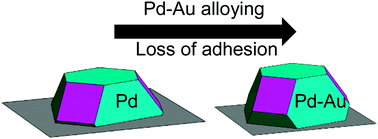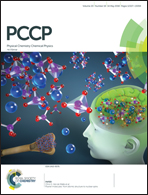Thermodynamics of faceted palladium(–gold) nanoparticles supported on rutile titania nanorods studied using transmission electron microscopy†
Abstract
Many physical properties of nanoparticles (NPs) are driven by their equilibrium shape (ES). Thus, knowing the kinetic and thermodynamic parameters that affect the particle morphology is key for the rational design of NPs with targeted properties. Here, we report on the thermodynamic ES of supported monometallic palladium and bimetallic palladium–gold (Pd–Au) single-crystalline truncated nano-octahedra (TOs) studied using aberration-corrected transmission electron microscopy (TEM). Monometallic palladium and bimetallic Pd62Au38 and Pd43Au57 TOs were grown by pulsed laser deposition on rutile titania (r-TiO2) nanorods exposing mainly (110) facets. Particle structure and dimension were first obtained from aberration-corrected high resolution TEM (HRTEM) images acquired parallel to the metal–oxide interface. By fitting an extended Wulff–Kaishev rule to the HRTEM data of the truncated octahedral thermodynamic ES in the size range of 2 to 5 nm, we secondly determined the interface and excess line energies associated with the particle–oxide–vacuum triple phase junction in Pd and Pd43Au57 TOs in the epitaxial relationship Pd(–Au)(111)〈101〉‖r-TiO2(110)[1−1−1] and in Pd62Au38 TOs in the epitaxial relationship Pd62Au38(100)〈101〉‖r-TiO2(110)[1−10]. Our results show a decrease in particle adhesion to the oxide support upon alloying Pd with Au. The loss in adhesion is tentatively attributed to an increase of the lattice strain induced at the metal–oxide interface as gold atoms are added to the palladium lattice.



 Please wait while we load your content...
Please wait while we load your content...